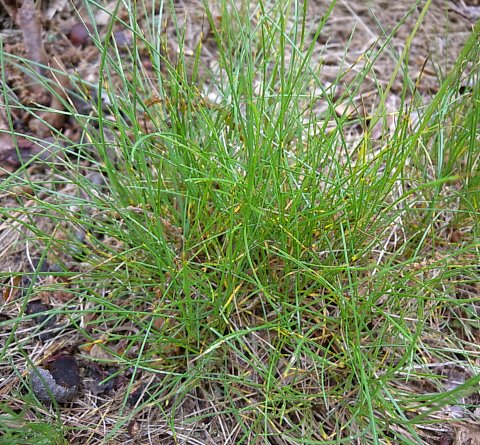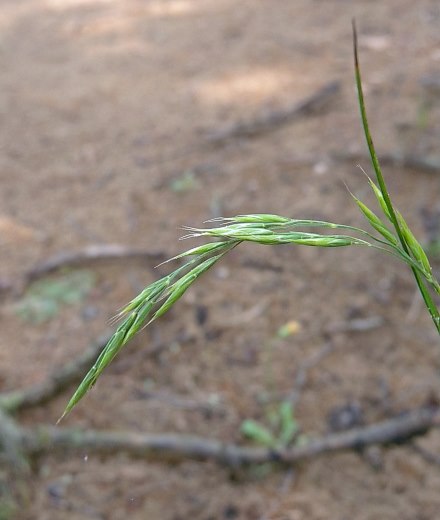
Each culm terminates in a panicle of spikelets about 1½-4" long. This inflorescence is either erect or slightly nodding. The central stalk of the inflorescence is slender, angular, and scabrous. At intervals along its length, there are erect to ascending branchlets about ¾-1½" long. The spikelets congregate toward the tips of these branchlets. Each spikelet has 4-7 florets and their lemmas; they are organized into 2 overlapping ranks. At the bottom of each spikelet, there is a pair of sterile glumes. One glume is 2.0-3.5 mm. in length, while the other glume is 3.5-5.0 mm. in length. Both glumes are linear-lanceolate in shape with convex outer sides. The lemmas are 4-5 mm. in length and linear-lanceolate in shape with convex outer sides; the tip of each lemma has an awn about 1-2 mm. in length. Both the glumes and lemmas are smooth to slightly scabrous; they are pale green while immature, becoming light tan at maturity. Each floret has an ovary with a pair of feathery stigmata and 3 stamens. The blooming period occurs from late spring to early summer, lasting about 2 weeks. The florets are cross-pollinated by the wind. Afterwards, the florets are replaced by elongated grains about 2-3 mm. in length. The root system is fibrous.
Cultivation: The preference is full sun, dry conditions, and a sterile soil containing sand or gravel. However, this grass will also tolerate a limited amount of shade and more moist conditions, if drainage is adequate.

Range & Habitat: The non-native Hard Fescue is widely scattered across Illinois, where it is relatively uncommon (see Distribution Map). This grass was originally introduced into North America from Eurasia as a source of forage. Habitats consist of sand dunes, gravelly areas along railroads, roadside embankments, pastures, and sterile waste areas. Areas with a history of disturbance are preferred.
Faunal Associations: Such insects as Oulema melanopus (Cereal Leaf Beetle), the leaf beetle Psylliodes cucullatus, Sphenophorus parvulus (Bluegrass Billbug), and Blissus leucopterus hirtus (Hairy Chinch Bug) feed on Hard Fescue and other Fescue spp. (Fescue Grasses). In addition, caterpillars of the skipper Atalopedes campestris (Sachem) and the moth Pediasia trisecta (Larger Sod Webworm) feed on these grasses. Cattle, sheep, and other domesticated farm animals will browse on the foliage of this grass when it is available in pastures. The seeds may be eaten by some upland gamebirds and songbirds, however specific information about this is currently unavailable for Illinois and other states of the Midwest.
Photographic Location: A sand dune at the Oak Openings Nature Preserve in NW Ohio.

Comments: This grass can be identified by its dense tufts of stiff leaves. It is one of the few grasses in Illinois that has filiform leaf blades with inrolled margins. In Illinois, there are two other species in the Festuca genus that share these characteristics: Festuca filiformis (Slender Fescue) and Festuca rubra (Red Fescue). In general, Slender Fescue is a more petite grass with smaller lemmas (2.5-3.5 mm. in length) that lack awns. Like Hard Fescue, it prefers habitats that are relatively dry and sterile. In contrast, Red Fescue is somewhat larger in size than Hard Fescue and its leaf blades are less stiff. Red Fescue has taller culms (up to 3' tall, although they often lean sideways) and its inflorescence tends to be longer (2-8" long). The taxonomic history of Hard Fescue is rather complex as it has a variety of scientific synonyms. In both the past and the present, Hard Fescue has been referred to as Festuca ovina duriuscula, Festuca duriuscula, Festuca trachyphylla (as used here), Festuca brevipila, Festuca stricta, and Festuca longifolia. It has also been lumped together with Festuca ovina (Sheep Fescue); this latter grass apparently does not occur in Illinois. Sheep Fescue is supposed to have gray-green or bluish leaves that are even more narrow and stiff than those of Hard Fescue. It is also a slightly smaller grass (½-1½' tall) with a shorter inflorescence (¾-2½" long), otherwise it is very similar to Hard Fescue. There is a popular cultivar of Sheep Fescue that has glaucous blue leaves; it is often referred to as Festuca ovina glauca.